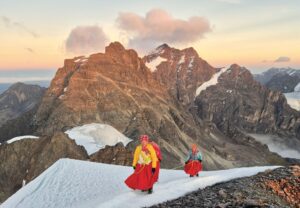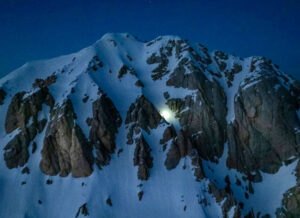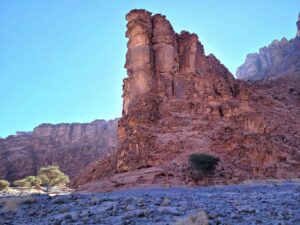On May 9, most New Zealanders were in the midst of an 11-day level 3 lockdown, in response to the COVID-19 pandemic. But on the same day, two hikers — called trampers here — ignored the restrictions and set off on an expedition that deteriorated into a 19-day survival ordeal in some of New Zealand’s most hostile bush.
Jessica O’Connor and Dion Reynolds are typical of Kiwis their age. They exude the trademark free spirit and passion for outdoor adventure. O’Connor is a kayak guide in New Zealand’s famous Abel Tasman National Park. Her employment history lists an enviable array of ski and kayak jobs in both Japan and New Zealand. She’s reportedly gentle, calm and somewhat earthy. Despite hippy-esque qualities, she has plenty of smarts in the outdoors.
Reynolds is the more outgoing of the pair, a long-haired chef with an adolescent energy. For New Zealand media, the pair are an easy target for assumptions that they’d messed up big-time in the bush. But in truth, the pair made key decisions that saved their lives.

Dion Reynolds and Jessica O’Connor’s outdoor smarts proved vital to their survival.
O’Connor and Reynolds set off into Kahurangi National Park, intending to follow the river and camp for a few days, then come out sometime before May 15.
They initially followed their planned route but soon ran into trouble. At their first campsite, they tried to dry their clothes after wading the river. “We ended up burning our socks,” recalled Reynolds. “I burnt three out of the four socks that I’d had.”
What unfolded next was a series of critical mistakes. The pair misjudged their distance — they’d walked further than expected — and lost their bearings. Fog set in and further disoriented the pair. They eventually realized that they were seriously lost and eventually made the wise decision to stay put. This probably saved their lives.

Kahurangi is New Zealand’s newest national park. It’s situated across both the Tasman and West Coast regions along the South Island and covers an enormous 452,002 hectares. Kahurangi is a complex place. The geology is largely made up of limestone and marble, with caverns, caves and sinkholes strewn throughout. Prime conditions for injury or worse, for those who lose focus or suffer fatigue. Kahurangi’s vegetation changes dramatically too, from dark damp beech forest in the east to ferns and vines in the west. It’s an uncharacteristically tropical scene for New Zealand, although the climate is anything but.
National parks make up more than 10 percent of New Zealand. A country known for adventure tourism is also a smorgasbord of rescue operations. In 2018-2019, the country spent more than 27 million NZD (US$17 million) on the search and rescue of more than 1,800 people. Just five million people live in New Zealand, and 95 percent of search-and-rescue workers are volunteers. New Zealand’s diverse climate means conditions can change rapidly, making weather an additional hazard to the challenging geography.

Kahurangi National Park is one of New Zealand’s most hostile environments.
In these conditions, three main things put life at risk: freezing temperatures, injury and starvation. Reynolds and O’Connor’s previous outdoor experience meant that they were at least carrying appropriate equipment for the conditions.
“The most vulnerable people are not those heading into the bush for a week or five days, it’s those who expect to be out there for just a few hours or the day, because they don’t have the extra equipment one would take on multi-day tramps,” said survival expert Stu Gilbert.
O’Connor and Reynolds’ high-quality tent and sleeping gear could preserve them indefinitely from the elements. However, they carried only five or six days of food. They also desperately needed to be nearer water.
“We only had two days of food left, and we were going down a gully, real steep,” recalled Reynolds. “It turned from a small rocky stream into pretty serious waterfall. On our way down, I twisted and sprained my ankle…We got to a waterfall that was 15-20m high, and we just looked at each other and realized we can’t go down that, we needed to go back up the hill and stop.”
O’Connor also hurt her back in a fall. With Reynolds’ sprained ankle, they chose to stay put as soon as they reached flat ground. Their new location was near a small clearing, just a two-minute walk to water. This move was crucial to their eventual rescue.
Heavy rain paused rescue attempts for a number of days. Temperatures dropped to -8˚C on some nights. Between 60 and 115mm of rain fell.
Yet the pair stayed level-headed and maintained their morale. They had spent 13 days without food when a rescue helicopter eventually spotted the smoke from their signal fire. They were winched to safety from the three-metre clearing by their camp.

It was an emotional reunion when the pair saw their family for the first time. Photo courtesy of Newshub
The pair’s minor injuries did not need treatment and they were released from the hospital on May 27. The New Zealand government decided not to press charges for the couple’s breach of the COVID-19 lockdown.
This is not the first time that fog in Kahurangi has caused a survival epic. In 1980, Peter Le Fleming spent 29 days lost. The 21-year-old hit his head and recalled almost nothing of the ordeal — a blessing, perhaps. When found, he weighed just 45kg –- 25kg less than when he started.






